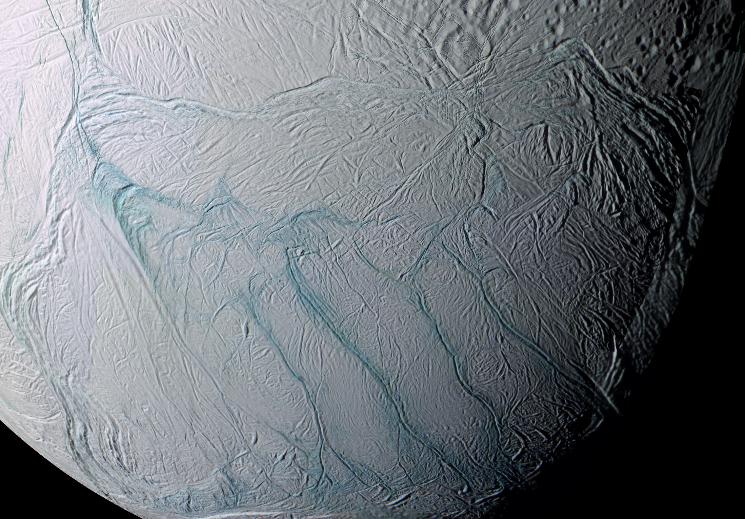
Enceladus (Voyager 2, 1981)
(Voyager Project, NASA, apod021204)
 A false-color image of the side of Enceladus which always faces away from Saturn, created by taking green and infrared images, coloring them to emphasize subtle "color" differences (note the "blue" areas on the left, probably related to grain size and reflectivity of the icy surface coating), and to "gray out" the image of Saturn, which is behind the moon, when looking at its anti-Saturn side. (solarsystem.nasa.gov)
Enceladus is only a little over 300 miles in diameter, but has an extremely varied terrain, with large impact craters, an extensive system of cracks and fissures, and a large expanse of smooth areas which indicate some kind of very recent resurfacing process. Until recently it was thought to have a density not much greater than that of water ice, but the close approach by the Cassini spacecraft which revealed its ice geysers indicated that it is nearly 30% the density of the Earth, suggesting that it must have a substantial rocky core. Radioactive decay of heavy atoms in that core is thought to produce the heat that supports the ice volcanism that produced its surface features, and feeds icy debris into Saturn's E ring, which occupies the same region as Enceladus, and has a substantially higher density at Enceladus' orbit. Gravitational interactions with Dione (which has locked Enceladus into an orbit with a commensurability of 1 to 2) and Tethys (which has a period very close to a commensurability of 3 to 4) may have also contributed some tidal heating, similar to that which Jupiter induces on Io, but on a much smaller scale. Whatever mechanism provides its heating, there is no question that very fresh, very clean icy material is released from the moon's interior and spread over its surface on a regular basis, giving the moon a remarkable albedo. Almost 99% of the sunlight which falls on it is reflected back into space, even more light than is reflected by some kinds of so-called "white" paper. This means that it only absorbs about 1% of the sunlight which falls on it, and as a result, Enceladus is even colder than the other moons of Saturn.
| How Albedo Affects Temperature The albedo or reflectivity of a planet or moon is one of the main factors which determines its temperature, especially for airless bodies. If an object absorbs a considerable amount of sunlight it will be warmer than if it reflects most of the light that falls on it. When bodies orbit the Sun at different distances, it can be difficult to see the effects of albedo on surface temperature, because the amount of sunlight which falls on them is quite different, and even if they absorb the same fraction of that sunlight they will have different temperatures. However, since the moons which orbit Saturn are all at the same distance from the Sun, we can see how their albedos affect their temperatures without the complication of differing Solar distances.
Phoebe, which has an albedo of only 6% and absorbs 94% of the sunlight which falls on it, has a surface temperature of about 260 degrees below zero Fahrenheit, while Titan, which reflects 80% and absorbs 20% of the sunlight falling on it surface, is 290 degrees below zero. Dione, which reflects 70% and absorbs 30% of the sunlight falling on its surface, is 305 degrees below zero, and Enceladus, which reflects 99% and absorbs only 1% of the sunlight falling on its surface, is 330 degrees below zero. In other words, the more reflective a moon is, the colder its surface is. (Note that these are the ground temperatures, and are not necessarily the temperature that you would have if standing on one of these moons.)
|

Ice fountains near the south pole of Enceladus. "Tiger-stripes" near the pole are apparently warm regions where ice and ice-water (which quickly freezes to become ice crystals) are heated and ejected into space near the moon, covering large portions of the surface with bright white crystalline ice. Exposure to solar radiation quickly converts the crystals into amorphous ice. The existence of crystalline ice previously showed that the tiger-stripes were active within the last decade. This image, taken as the Cassini spacecraft passed behind the moon as seen from the Sun, shows ice fountains brightly lit by the sunlight streaming through them. (Cassini Imaging Team, SSI, JPL, ESA, NASA, apod051205)

Ice geysers on Enceladus as imaged by the Cassini spacecraft during its Nov 21, 2009 flyby
(NASA/JPL/SSI; Mosaic: Emily Lakdawalla, apod091124)

Tiger-striped regions (shown in a very exaggerated blue color) near Enceladus' south pole are at least 15 Kelvins (about 30 Fahrenheit degrees) warmer than the surrounding regions. Meltwater below the regions is ejected through the fountains shown above, covering the moon's surface with fresh bright water ice, and filling the region near its orbit with oxygen atoms resulting from the dissociation of the water molecules. (Cassini Imaging Team, SSI, JPL, ESA, NASA, apod060310)
| Data for Enceladus
Discovered by William Herschel in 1789
Named after one of the giants who sprang from the union of the blood of Uranus and the Earth
Orbital size 238,000 km (approximately 148,000 miles)
Orbital eccentricity 0%
Orbital inclination 0 degrees
Orbital period 1.37022 days
Rotation period 1.37022 days (synchronous rotation, one side permanently facing Saturn)
Diameter 515 x 495 x 490 km (about 320 x 308 x 304 miles)
Mass 1/50000 of Earth, 1/600 of Earth's Moon
Surface gravity 1.1% of Earth, 1/16 of Earth's Moon
Density 1.6 times density of water (implies substantial rocky core beneath icy mantle)
Albedo (reflectivity) 99%
Surface temperature 330 degrees below zero Fahrenheit
|
|